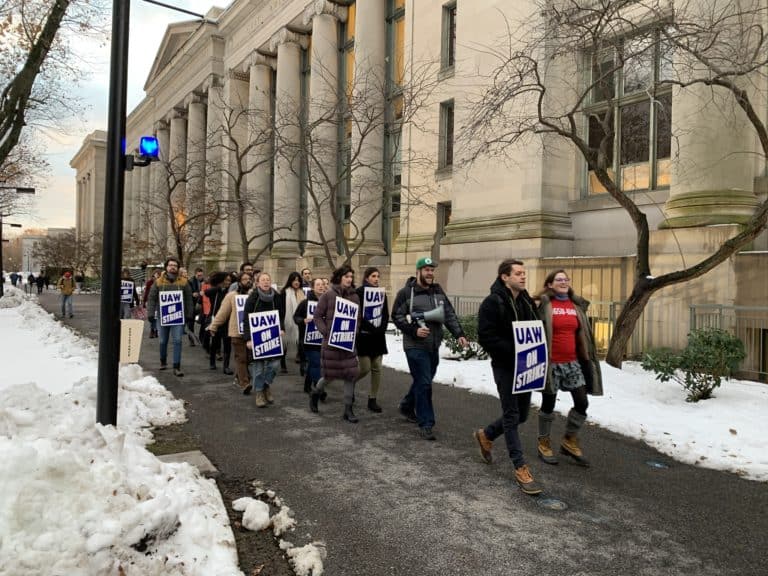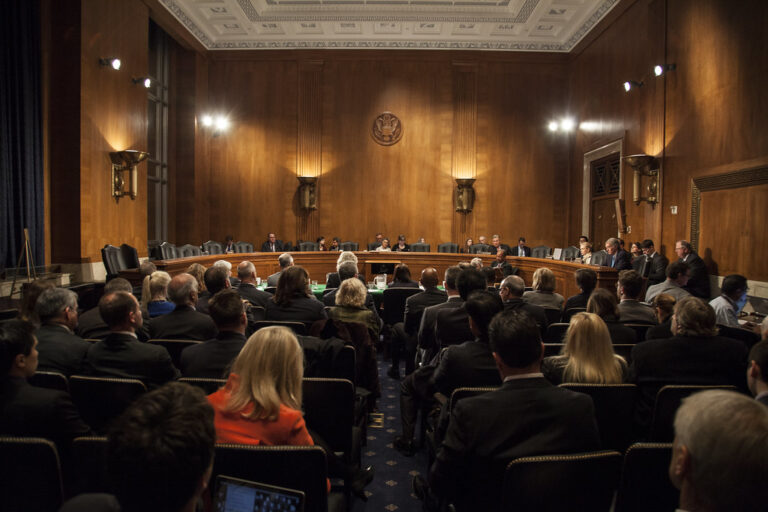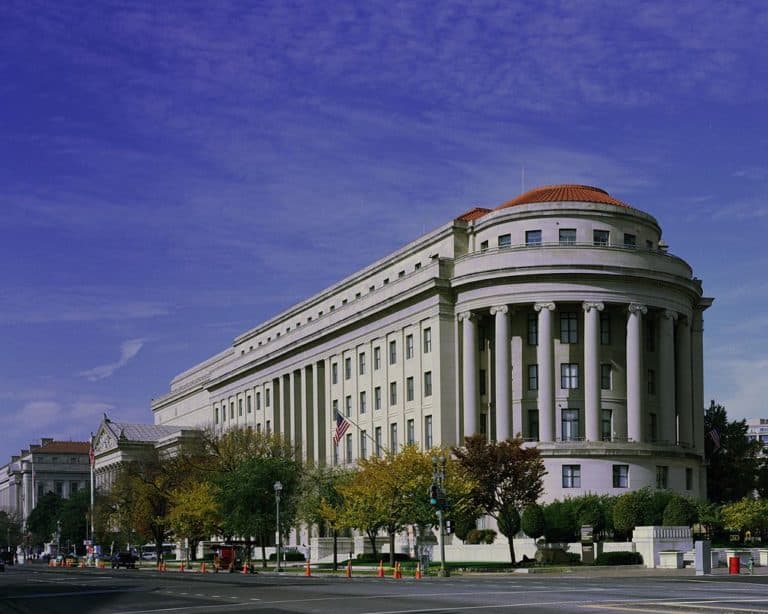Hannah Finnie is a writer in Washington, D.C. interested in the intersections of work and culture. She is a graduate of Harvard Law School.
Kim Kelly spent nearly two decades covering heavy metal as a journalist, which is how she wound up as the heavy metal editor at the Vice vertical Noisey. But then Vice, like many digital media outlets across the United States since 2015, began unionizing. For Kelly, that first-hand union experience led to a shift not just in her personal interest in labor, but in her professional interest, too.
“I’d always been interested in labor as a result of a broader personal interest in working class history and political movements,” she told me, “but it took actually living the union struggle to make me realize that it might be time to leave blastbeats and corpsepaint behind, and use my platform in another way.” She now covers labor full-time.
There’s been ample coverage of the media organizing wave that swept up Kelly and Vice: since June 2015, when Gawker kicked off the wave by unionizing, at least 80 media organizations big and small across the U.S., U.K., and Canada (primarily digital media and U.S.-based) have unionized. But, surprisingly, there’s been much less reporting about how this unionizing wave affects media coverage of unions.
Pre-wave labor coverage wasn’t great: A 2013 study of the four major broadcast networks found that only 0.3% of the networks’ stories were about unions. While broadcast and print or digital media can differ, it’s fair to say that over the last few decades, labor hasn’t gotten a ton of coverage in non-broadcast media either. Steven Greenhouse, who was The New York Times labor and workplace reporter, tracks the low point for labor journalism to the early 2000s when unions were going through a slow period, a lot of newsrooms were laying off staff, and, he tells me, the labor beat often seemed one of the first to go. The Great Recession and growth in digital media outlets, he says, reversed the trend and prompted increased coverage of labor and workers. But what about the rise of not just digital media outlets, but unionized digital media outlets?
While not every person in digital media who’s experienced unionizing becomes, like Kelly, a labor reporter overnight, it’s hard to imagine that the effects of being in a union have no impact on their work. After all, while unions are about benefits and wages, they’re also about worker dignity, principles that can inform more than just what your paycheck looks like. What happens to labor coverage when there are thousands of Kim Kellys out there? Thousands of people who now know what it’s like to unionize and have a large (albeit constrained) platform through their media outlet? What does that shift mean for media labor coverage?
One effect is a jump in the number of labor stories. Hamilton Nolan, who was involved in the Gawker unionization and writes about labor, told me in an interview that he believes, at least anecdotally, that coverage has increased. “When I wrote about unions in say 2012 it felt very niche in a way that it does not today, and I can think of a lot of great younger reporters who [now] cover labor regularly.”
One possible reason? A deeper understanding among journalists of how unions connect to their beats, which they may not have seen before. Matt Pearce, a journalist at the Los Angeles Times and president of the newsroom union, told me in an email that he experienced this evolution: “…I can tell you on a personal level that going through the organizing process made me significantly more aware of potential labor angles to stories that I might have otherwise overlooked.”
In addition to seeing more connections to labor, journalists may simply want to write about labor more because of an increased personal – and by extension, professional – investment in the labor movement. Or, as Nolan puts it: “Any media company that chooses to try to fight against its own union is also choosing to have a staff that is much more focused on labor coverage going forward, and much more passionate about it.”
While it’s possible there are simply more labor stories to cover now (like media unionization itself but also the 2018 teachers’ strikes and high-profile organizing at companies like Alphabet), to say that’s the full answer would be dismissive of the newfound appetite journalists have for covering unions. And this uptick likely isn’t confined to unionized outlets. Similar to the way unions tend to benefit non-unionized workers around them, unionized outlets likely affect coverage at non-unionized outlets, too. Journalists at unionized organizations inevitably leave and go to other workplaces, bringing their perspectives with them.
But there aren’t just more labor stories now. There are also different kinds of labor stories.
While Greenhouse doesn’t believe unionizing has changed labor journalism much, he does think it’s possible unionizing could encourage more journalists to write from a pro-labor perspective, particularly at newsrooms that allow for it.
The unionizing wave may be a lot of journalists’ first personal experiences with unions. Union membership has been declining for decades and people—journalists included—are a lot less likely to have had a relative or close friend involved with a union. It’s incredibly easy to be an adult today who has no idea how a union actually works—but actually being in one changes that. It makes you more fluent in the language of unions, how card-collecting and bargaining works, and how management may try to union-bust even when it insists, really, truly, it’s not.
In other words: unionizing may have made a whole generation of journalists into more experienced, discerning labor reporters.
That allows labor coverage to shift away from headline-grabbing events like large strikes and union corruption (staples of traditional labor reporting) and more to what Kelly calls “the nitty-gritty labor coverage that people truly need and deserve.” In other words, what counts as a “newsworthy” labor event is changing. The same 2013 study that found a paltry amount of labor coverage also found that when there actually was a story on labor, it was much more likely to be focused on labor protests and pickets than on contract negotiations or charitable and social services labor organizations have performed.
While television news may not directly correlate with digital media, it seems likely that as journalists become more familiar with how unions work, their stories would reflect that nuance, too. When, for a lot of us, all we learn about unions is a mention of the Pullman Strike in our high school history classes, it might be hard to understand the gravity of a negotiation over the size of a bargaining unit. But the reality is those back-and-forths are just as critical to understanding the state of labor than large strikes, and it’s important to have a media ecosystem that understands that, too.
If labor coverage is already changing, what’s next?
“If Vice had just paid me fairly and treated me better while I was there,” Kelly told me, “I might still be writing album reviews instead of reporting on the Amazon union drive in Bessemer, Alabama right now.”
Maybe the question, then, isn’t what does thousands of Kim Kellys mean for media coverage of labor, but what does thousands of Kim Kellys mean for labor itself?






Daily News & Commentary
Start your day with our roundup of the latest labor developments. See all
November 24
Labor leaders criticize tariffs; White House cancels jobs report; and student organizers launch chaperone program for noncitizens.
November 23
Workers at the Southeastern Pennsylvania Transportation Authority vote to authorize a strike; Washington State legislators consider a bill empowering public employees to bargain over workplace AI implementation; and University of California workers engage in a two-day strike.
November 21
The “Big Three” record labels make a deal with an AI music streaming startup; 30 stores join the now week-old Starbucks Workers United strike; and the Mine Safety and Health Administration draws scrutiny over a recent worker death.
November 20
Law professors file brief in Slaughter; New York appeals court hears arguments about blog post firing; Senate committee delays consideration of NLRB nominee.
November 19
A federal judge blocks the Trump administration’s efforts to cancel the collective bargaining rights of workers at the U.S. Agency for Global Media; Representative Jared Golden secures 218 signatures for a bill that would repeal a Trump administration executive order stripping federal workers of their collective bargaining rights; and Dallas residents sue the City of Dallas in hopes of declaring hundreds of ordinances that ban bias against LGBTQ+ individuals void.
November 18
A federal judge pressed DOJ lawyers to define “illegal” DEI programs; Peco Foods prevails in ERISA challenge over 401(k) forfeitures; D.C. court restores collective bargaining rights for Voice of America workers; Rep. Jared Golden secures House vote on restoring federal workers' union rights.